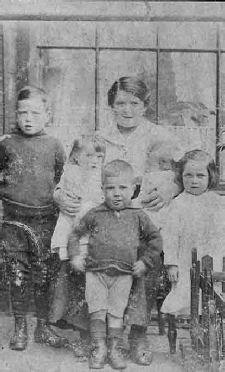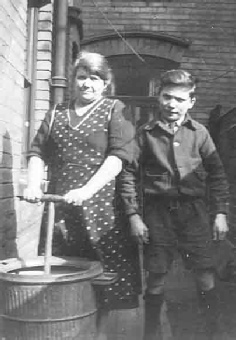

Back to back and Court housing
From the end of the 1700s several of our ancestral families gravitated to the developing industrial Birmingham, the sudden increase in population lead to a new type of housing. The small houses were built in courts around a communal square. The square had a tap, a line of toilets, a “midden” where the waste bins were kept, and the clothes lines. Some courts also had a communal “brew house” where the laundry was done but this wasn’t the case in the court where John George and Ria raised their family. Some of the houses had a small garden plot surrounded by low paling fences. At least one side of the square consisted of back to back houses. That is, the houses were built so that half fronted on to the main street while the ajoining back was a separate dwelling fronted into the court. The houses in the court were accessed through an entry through the front houses. George and Ria lived in a house of this type 4 Back 41 Guildford Street. You can see part of the garden fence in the photograph of Ria with five of her fifteen children. Yes fifteen children in a house with a scullery, kitchen and parlour in a line downstairs and a main bed room above the parlour and an attic above that the upper floors reached by a narrow stair way.
This type of house is well described by Kathleen DAYUS in her autobiography “The Girl from Hockley”
“They were all built the same; one large living room, one bedroom,and an attic. There were also cellars that ran under each house.” The Dayus family had 6 children and the parents in their tiny house the Pratts had 13 children and the parents at one time in theirs. Kathleen’s two older brothers had a bed in their parents room. The oldest sister had a bed in the attic while the three youngest children shared another bed in the attic. In the Pratts house the two youngest had a cot at the foot of their parents bed the two girls had a bed in the same room separated from the parents bed with a curtain and the boys slept in two beds the attic four to a bed. They eventually moved to a house with the luxury of a back kitchen jutting out and a small garden, but like the Dayus household they still had to share a toilet and tap in the yard with the other houses in the court.
Bath night
Bath night was a similar example of getting maximum use of the heated water. Again the copper was filled by the boys with their buckets and the fire lit. First everyone was locked out “to play” while mother scooped hot water into the zinc bath in front of the copper fire surrounded be a large clothes horse which held her clean clothes and towels once she had finished the boys were bathed staring with the youngest and working up the girls helped with the babies dressing them and putting them to bed while the older boys bathed. The babies slept in a cot at the bottom of their parents bed in the same room as the two girls, whose bed was curtained off form the main area. The remaining boys slept in the attic. Gradually everyone was bathed and put to bed until father enjoyed the remaining tub By the time he had finished the fire had gone out and the last water in the copper was cool enough for the two girls to jump in for their dip. Again once they had finished the remaining water was used to scrub the floors.
The copper was occasionally used to cook steam puddings especially the special Christmas puddings. Ria always made huge quantities for their own family and as gifts for relations and poor acquaintances.
Having so many houses opening on to the square meant the children were able to play there safely there was always someone in earshot or keeping an eye on them.

4 Back 41 Guildford Street
Ann Maria PRATT [1197] nee HALL known as Ria with from left to right:
John George (Jack) born 1909, Daisy May born in 1915, Harold Leslie born in 1914, Herbert born in 1916 and Kate Beatrice born in 1913.
[A daughter Violet had also been born in 1911 and had died soon after birth.]
You can just see the fence around the vegetable plot.
It is thought that the photograph was taken about 1917 to send to her husband John George who was serving abroad with the 3rd South Staffordshire Regiment and the Labour Corp.
Washing Day.
The zinc bath was kept on a nail in the scullery, where they had a built in “copper”, a boiling tank built into a brick surround over a hearth. So on washing day the fire was lit very early in the morning. The boys filled the copper with buckets of water carried from the tap in the communal square. First the white linen was put in for a boiling This was transferred to a dolly tub ready for pounding with the dolly stick or agitated with a posser.
Meanwhile the coloured clothes were put in the copper which would have been topped up with more water. The whites were next scrubbed with soap on a scrubbing boars rinsed in the zinc bath and put in more clean water to which a blue bag had been added.
The bath had been placed under the mangle to catch the water squeeze from the washing as it passed between the rollers, Now it was ready to hang on the line along with the washing of the other court dwellers. The whole procedure was repeated with the coloured wash and finally with the heavy working clothes. When the girls came home from school they tied sacking around their waists before they scooped the remaining water from the copper to scrub the scullery and kitchen floors then they carried the rest to the toilets and scrubbed the floors there. Very little water was wasted.

This photograph is of Ria using a dolly tub with her youngest son and was probably taken at the back of 254 Frederick Rd.
Site layout and content © 2007-